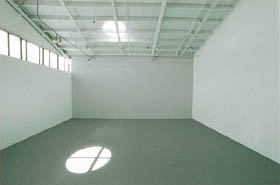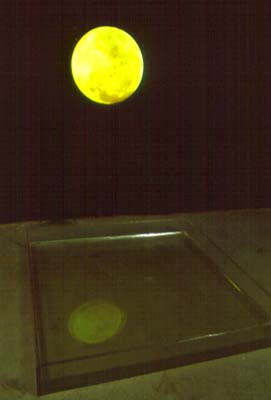The artist Olafur Eliasson will be speaking at the Hirshhorn Museum in Washington DC about his work, including last year’s The Weather Project at the Tate in London.
Olafur Eliasson, The Demetrion Lecture: Wednesday, Nov. 17 at 7pm. [Hirshhorn.si.edu]
Tag: olafur eliasson
On an Unrealized Art Project
In 1999, I conceived and contrived to make a piece of art. It began as an idea for a commission for the artist Olafur Eliasson, but my idea was so embarassingly specific and complete, there’s no way I could bring myself to ask him to do it. Even though I cannot imagine myself as an artist, or a maker of art, I had to admit that this was not an Eliasson, it was Eliasson-esque, at best.
The piece is a sort of reverse sundial.*
Our apartment in NYC faces north, and so receives no direct sunlight. At various times in the day, the sun would reflect off of windows across the street, creating sharply angled patches of bright light, which would move across the wall or floor, marking a specific moment in the day.
I devised to place a mirror on the roof of the recluse’s townhouse across the street, which would reflect sunlight directly into our apartment. It would have a motor which would track the movement of the sun, thereby maintaining the reflecting angle throughout the day. [Constructing this motorized mirror was a great obstacle. Last year, when I finally told Olafur about this piece, he said a German company made such a mirror, called a heliostat, which was exhibited at the Hanover 2000 Expo.]
Rather than the naturally changing light of a normal day, the apartment would receive constant, consistent, direct light. The light wouldn’t shift, the shadows wouldn’t lengthen, then contract. At first, the brt lt praised by realtors and sought after by apartment hunters would be welcome, but I expected that, after a while, it would become unnerving, even maddening.
[2007 update: soon after posting this, I told this story to a couple of Olafur’s dealers, who, instead of laughing with/at me, said I really should have proposed it to Olafur, because he would have loved doing it. Which is a huge bummer, because then I could have paid 1999 Olafur prices for the piece. Oh well, it’s mine now.]
* Olafur actually made a sundial-like piece in 1997 by cutting a round hole in the roof of the Marc Foxx gallery in Los Angeles. The circle of light tracked beautifully across the empty gallery space. The piece was titled, Your Sun Machine. I never dreamed to call my piece My Sun Machine, though.

Sun Set
This is the last weekend to see Olafur Eliasson’s installation, The Weather Project in the Tate’s turbine hall. The museum’s keeping the hall open until 1AM on Friday and Saturday, apparently because they’re unsatisfied with only 2 million visitors.
For added enjoyment, the Guardian published a diary from the Tate’s manager, the one who had to deal with troupes of Santas, didgeridoo players, a man in a canoe, and people hooking up under the mirrored ceiling.
[3/20 update: Michael Kimmelman interviews Olafur in his Berlin studio about TWP. Re the headline, the Arts & Leisure section closes on Tuesday night. Great minds, etc., etc. “The Sun Sets at the Tate Modern]
Olafur Eliasson’s The Weather Project
As you’ll never see it again… As B.Logman’s photos and news reports indicate, The Tate Modern has a massive-crowd-pleasing phenomenon on their hands. Now suddenly this photo I took at the preview seems worth posting, if only because who knows if it’ll ever happen again.

More Olafur Eliasson Pix


The Weather Project, 2003, Olafur Eliasson, at the Tate Modern
The top one’s shot in the mirrored ceiling.
I’m working on it, but right now, I got nothing that’ll top this.
Olafur Eliasson: The Weather Project at Tate Modern

Just got back from the preview and party for The Weather Project, Olafur Eliasson’s absolutely breathtaking installation at the Tate Modern in London. The Turbine Hall is something like 500 feet long, the full length and height of the building.
I can tell you that Olafur created a giant sun out of yellow sodium streetlamps, but that doesn’t begin to describe the experience of seeing it and being in the space. It is this awareness of one’s own perception which is at the heart of his work. Not only does he use and transform this unwieldy cavern, he intensifies the viewer’s sight and sense of being in the space.
And as always, Olafur lays bare the mechanisms that create the unavoidably sublime experience, which in this case include, literally, smoke and mirrors. You can see exactly how you’re being
[update: the Guardian‘s Fiachra Gibbons likes it, too.]
Reflecting on

Michael Elmgreen & Ingar Dragset, Powerless Structures, No. 59 [image via]
A friend‘s web writing has plummeted in frequency while rising in substance. This paragraph triggered a cascade of images:
and so yesterday you asked yourself, naturally, under an impossibly full moon, in the middle of another state, in the middle of the woods, blue-gray light spilt over the water’s gently trembling surface, the hypnotic criss-cross of ripples, the disappeared stars, the misty gray-blue air that spoke of you never being alone, even when alone: “but what is the double-grief?”.
Elmgreen & Dragset’s piece (above) was in a 1999 show at The Project. (They show at Tanya Bonakdar now.) It was in the basement, a low-tech sublime landscape. An effable reflection, made permanent (as long as you accept its completely manmade nature).
Last week, as I climbed into bed in NYC, an unusual light shone from across the street. It’s not the retro streetlamp, but far higher. You can’t see the sky from our north-facing parlor floor apartment, either. It’s the moon, nearly full, at just the right angle to reflect in the fifth floor window of my neighbor’s townhouse. Sit up, lie down. Sure enough, it’s only visible from this one spot. In a few minutes it disappears. Could I have captured it on film? with the digital camera? No, the flash’d go off and I’d have a stupid snap of my wall. How do I know?
A morning in a Hawaii, where the door to our hotel room faced due east. Stepping from the shower, an exclamation. A circular rainbow, not six inches across, projected on the far wall. We studied and stared for several minutes, watching the sun shine straight through the peephole. Hurriedly, we dug out the digital camera and snapped away. Flash, flash. Nothing, but over-illuminated bamboo-esque furniture. We had to content ourselves with the knowledge that Olafur Eliasson could probably recreate the phenomenon, if asked. He made this, after all…
Some things, it seems, cannot be captured, only approximated. Recreated. Reflected.

